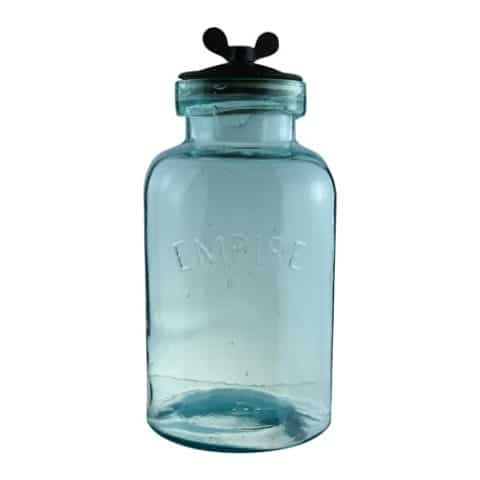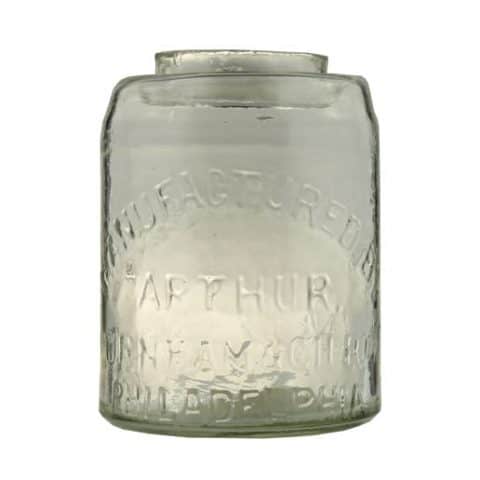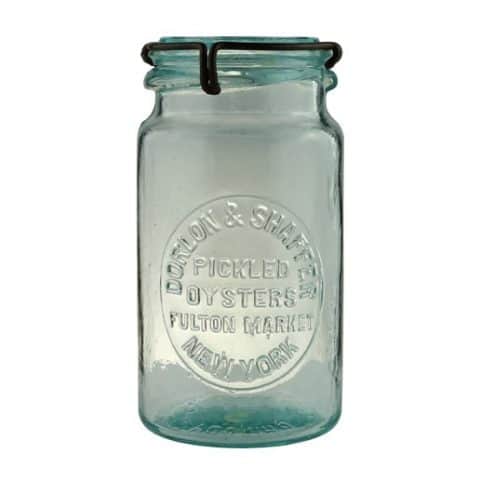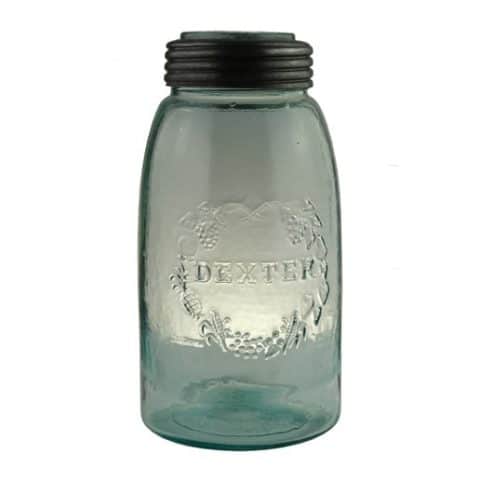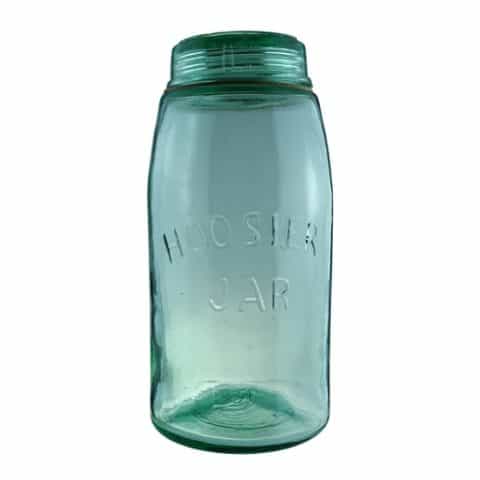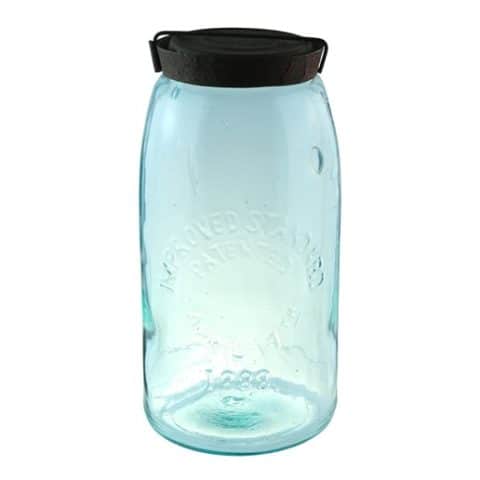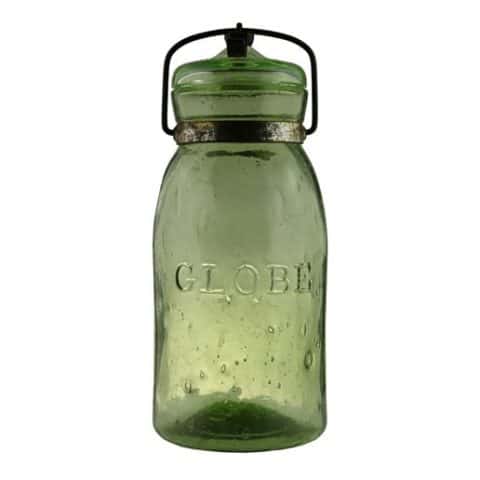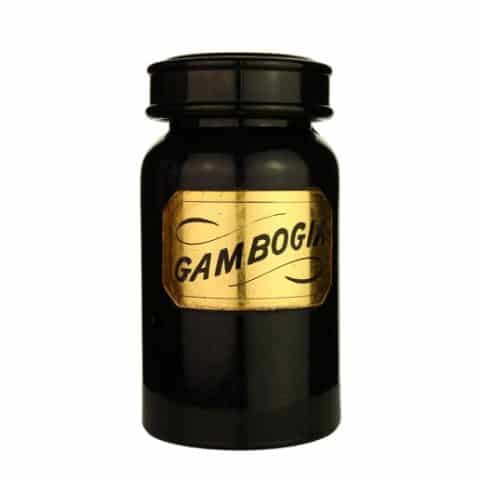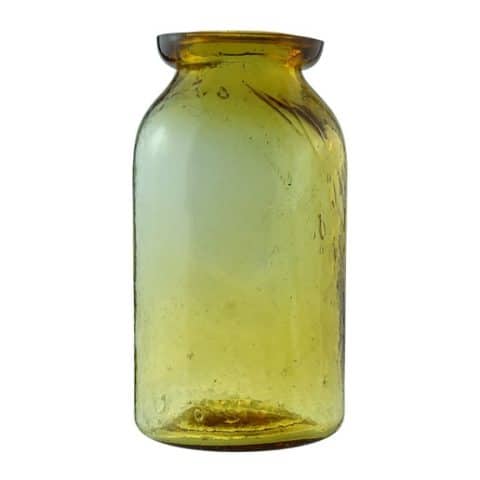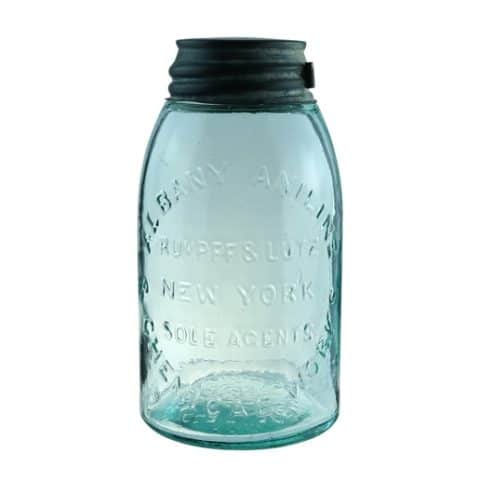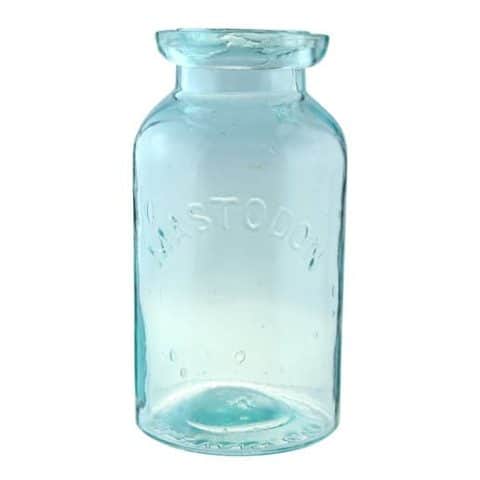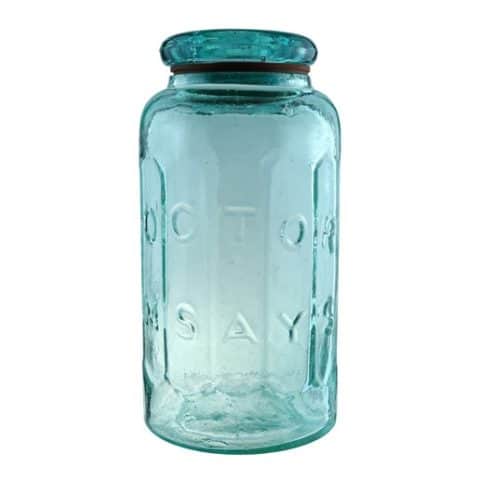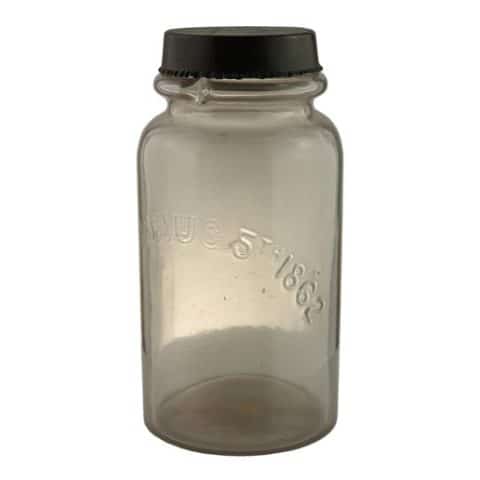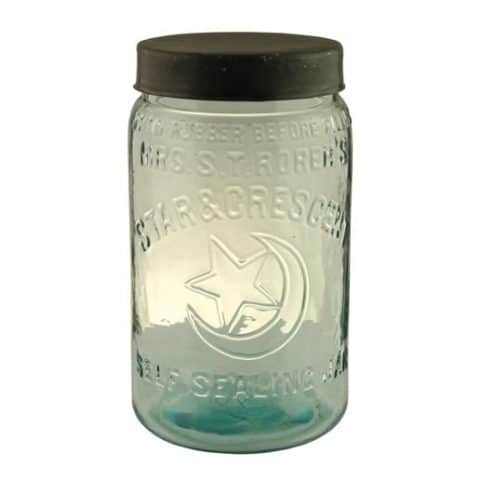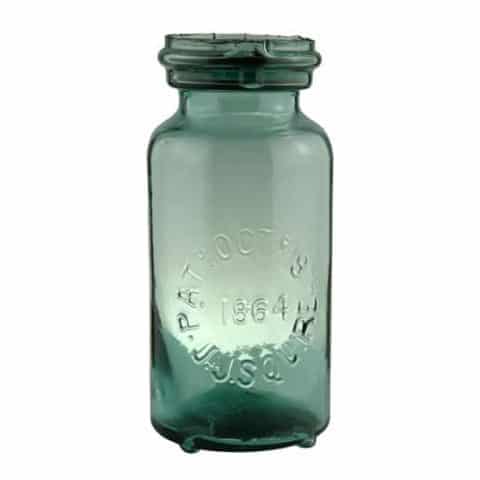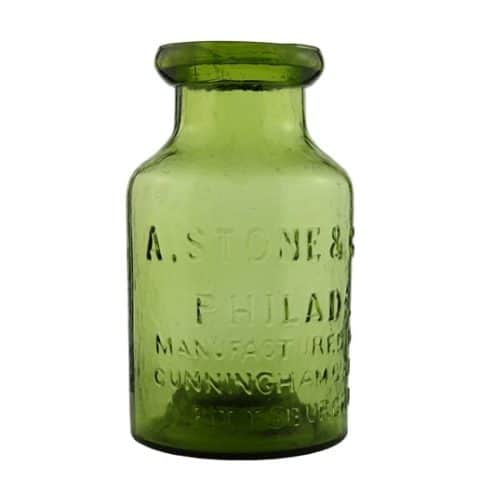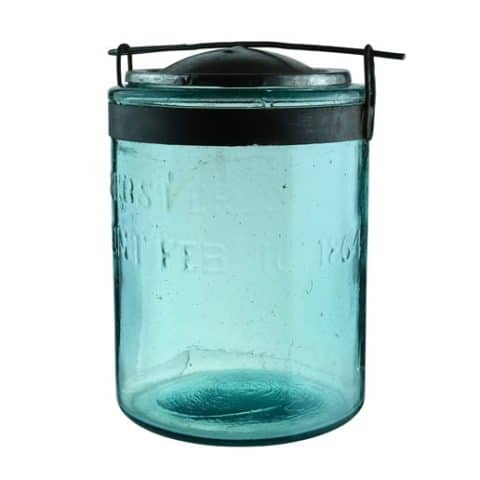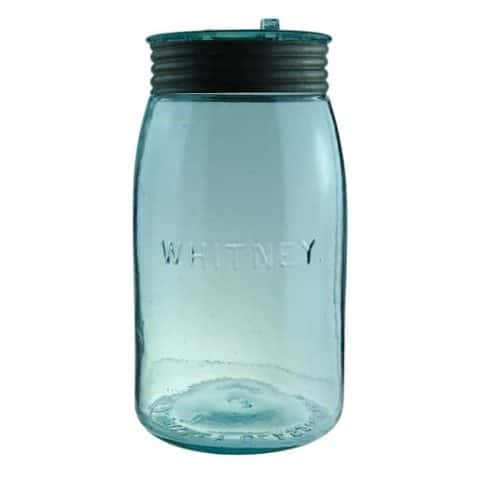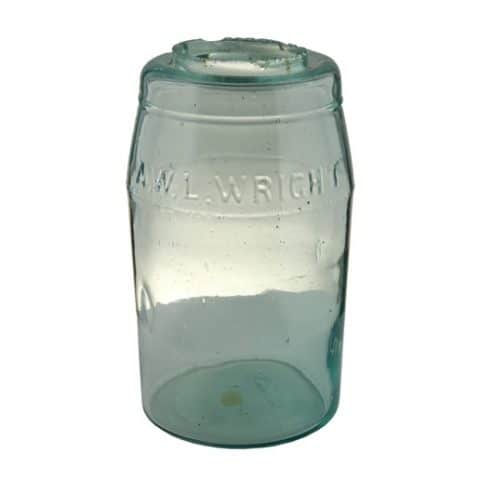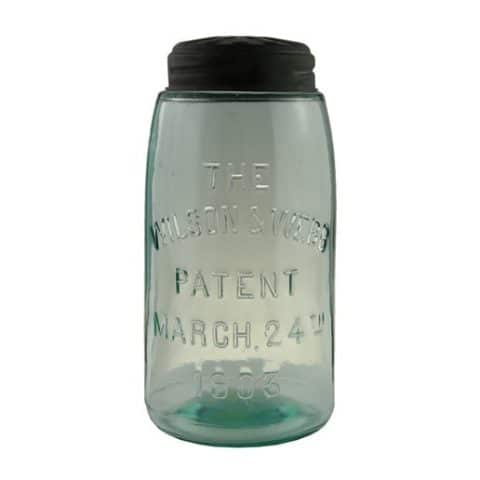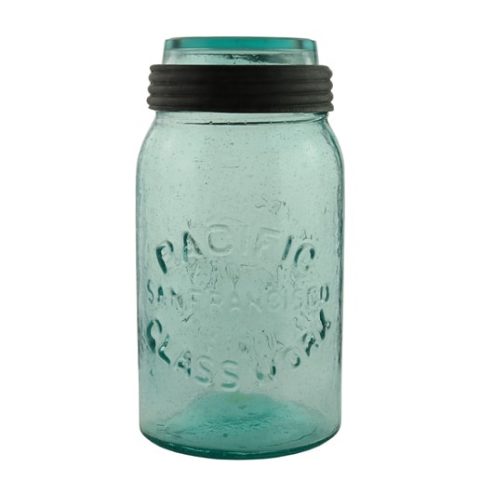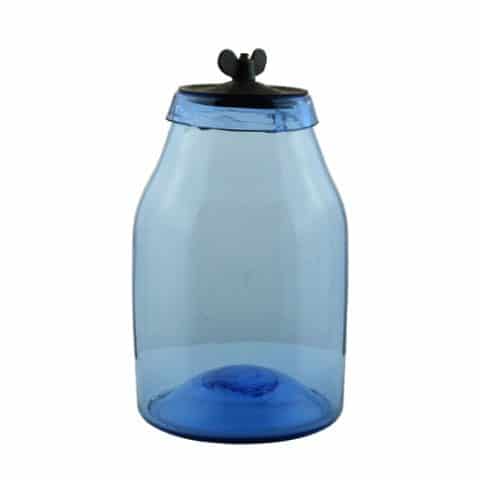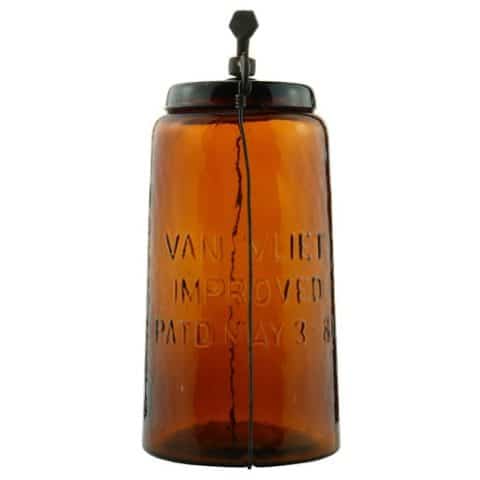Potter & Bodine’s Air-Tight Fruit Jar
Potter & Bodine’S
Air-Tight Fruit Jar
Philada
PATENTED APRIL 13TH 1858
David Potter & Francis I. Bodine, Bridgeton, New Jersey
Aquamarine Half-Gallon
Provenance: Jerry McCann Collection

Our museum example is an extremely rare, straight-sided Potter and Bodine’s Air-Tight Fruit Jar that was hand blown. The jar has a tooled lip that is fire polished. The closure is a wax seal with a grooved ring that uses a metal cap. The Potter & Bodine’s Air Tight Fruit Jars can be found in a figural barrel form and straight-sided forms with variants.
See the museum example of the predecessor Air-Tight Fruit Jar.
See the museum example of the related Ravenna Glass Works Ohio Air-Tight Fruit Jar.

The face of the aquamarine jar is embossed in four stacked straight horizontal lines reading, ‘POTTER & BODINE’S’ (1st line), ‘AIR-TIGHT’ (2nd line), ‘FRUIT JAR’ (3rd line), and ‘PHILDa’ (4th line). The reverse of the jar is embossed in three straight horizontal straight lines, ‘PATENTED’ (1st line), ‘APRIL 13TH’ (2nd line), and ‘1858’ (3rd line).
The jar patentee was Joseph Borden of Bridgeton, New Jersey. His patent was assigned to David Potter and Francis I. Bodine who were the proprietors of Bridgeton Glass Works. The patent read “Improvement in Preserving-Jars. Specification forming part of Letters Patent No. 19,964, dated April 13, 1858.’

I claim a preserve jar, in which the cup or groove for holding the cement is formed on the exterior from the wall of the jar by the method described. I do not claim heating the draught air before it is introduced into the furnace or heater. But I claim introducing the draught air in a thin sheet around the top of the oven and sides substantially as described, whereby the heat, which otherwise would radiate from the outer surface of the oven, is employed for improving the combustion in the furnace or heater. I also claim the strips or plates, b d, arranged in the inclosed air spaces substantially as described, for the purpose of confining the heated air closely to or near the inner case of the oven as specified.
Joseph Borden, of Bridgeton, N. Y., (assignor to David Potter and Francis I. Bodine
The patent was for a process to form the wax (cement) groove by pushing down with a forming tool on the jars top while the glass was still workable.
Before the advent of the snap case holder, the lip tooling operation would have required the attachment of a pontil rod to the base of the jar in order to hold the jar, thus the early barrel-shaped jars have pontil marks while later forms usually do not. A few of these jars have an iron pontil scar but the majority of these jars have an improved glass pontil scar.

The barrel shape was patented by Francis L. Bodine on March 20, 1877. It was assigned to the Cohansey Glass Manufacturing Company. This firm continued to sell them as their “Cement Jar” until 1881.
The Bodine family operated a series of glass companies at two locations in New Jersey starting in 1836 when Joel F. Bodine, a former stage line owner started the Williamstown Glass Works. Bodine brought his three sons, John F., William H., and Joel A. Bodine (also known as J. Alfred), into the firm in 1846, the same year the family purchased the Bridgeton Glass Works.
Our museum jar was produced somewhere between 1858 to 1863 by the Bridgeton Glass Works in Bridgeton, New Jersey. Prior to this, Maul, Hebrew & Co. bought the plant from the Bodines in 1855. Maul, Hebrew & Co. was comprised of William Maul, Joseph Borden, and a man named Hebrew. The undertaking failed rather quickly, as the works were offered at public sale by the sheriff the same year. At that point, the Bridgeton Glass Works was taken over by David Potter and Francis l. Bodine. Potter and Bodine were addressed at 107 Chestnut Street in Philadelphia, Pennsylvania in 1858 selling their Potter & Bodine’s Patent Air-Tight Fruit Jars. (see advertisement below).

Primary Image: The Potter & Bodine’s Air Tight Fruit Jar imaged by the FOHBC Virtual Museum midwest studio by Alan DeMaison.
Support: Reference to Fruit Jar Annual 2020 – The Guide to Collecting Fruit Jars by Jerome J. McCann
Support: Reference to Red Book #11, the Collector’s Guide to Old Fruit Jars by Douglas M. Leybourne, Jr. Use of Creswick illustrations courtesy of Doug Leybourne.
Support: Reference to The Bodine Glass Companies by Bill Lockhart, Beau Schriever, Carol Serr, and Bill Lindsey
Support Image: Rare Potter & Bodine #2383-1 Aqua Fruit Jar, American, Philadelphia, ca 1858. Quart size wax sealer embossed POTTER & BODINE’S AIR-TIGHT FRUIT JAR PHILADa on front; reverse PATENTED APRIL 13th 1858 on two lines. Incomplete neck-wax seal grove missing; 6.5″ overall height. (See Leybourne 2001: 315) Condition: Some residue; evidence of contents under seal-grove. – Cowan’s Auctions
Support Image: Auction Lot #1: embossed “POTTER & BODINE (arched) / AIR-TIGHT / FRUIT JAR / PHILADA”, reverse with “PATENTED (arched) / APRIL, 13th, / 1858″, plain domed base. Aquamarine, Circa 1860. Undamaged. 9 ½” high. Recently discovered in the basement of a stone house in the Shenandoah Valley of Virginia. Reference 1: Leybourne – Fruit Jars, no. 2384. – Jeffrey S. Evans & Associates
Support Images: Auction Lot 15339: POTTER & BODINE’S AIR TIGHT Figural Barrel Pint, Pontil, Aquamarine, Closure: Push-down style grooved ring wax sealer mouth finish and comes with an early tin cap (has some dried canning residue trapped in the channel) Appearance: Sparkling glass. Condition: No damage. Embossing: Strong. Base: Pontil scar. Age: c1860. Availability: Scarce in this small size – Greg Spurgeon, North American Glass
Support Images: Five images from the Jeff Vanaman collection including two straight side Botter and Bodine examples, a football-shaped front embossing, two different rear embossings, a 2-line, and a 3-line version. “All are considered very scarce. On one example, the front embossing almost runs off the jar. Very sloppy mold making.”
Support Image: Pale yellow quart script POTTER & BODINE’S – Greg Spurgeon, North American Glass
Join the FOHBC: The Virtual Museum is a project of the Federation of Historical Bottle Collectors (FOHBC). To become a member.





















